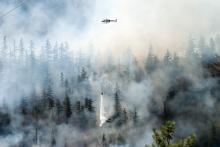Where there’s smoke, there is fire. But with climate change, larger and longer-burning wildfires are sending smoke farther from their source, often to places that are unaccustomed to the exposure. That’s been the case this week, as smoke continues to drift south from massive wildfires in Canada, prompting warnings of hazardous air quality, and poor visibility in states across New England, the mid-Atlantic, and the Midwest.
As wildfire season is just getting going, many may be wondering: Are the air-polluting effects of wildfires a new normal?
MIT News spoke with Professor Colette Heald of the Department of Civil and Environmental Engineering and the Department of Earth, Atmospheric and Planetary Sciences, and Professor Noelle Selin of the Institute for Data, Systems and Society and the Department of Earth, Atmospheric and Planetary Sciences. Heald specializes in atmospheric chemistry and has studied the climate and health effects associated with recent wildfires, while Selin works with atmospheric models to track air pollutants around the world, which she uses to inform policy decisions on mitigating pollution and climate change. The researchers shared some of their insights on the immediate impacts of Canada’s current wildfires and what downwind regions may expect in the coming months, as the wildfire season stretches into summer.
Q: What role has climate change and human activity played in the wildfires we’ve seen so far this year?
Heald: Unusually warm and dry conditions have dramatically increased fire susceptibility in Canada this year. Human-induced climate change makes such dry and warm conditions more likely. Smoke from fires in Alberta and Nova Scotia in May, and Quebec in early June, has led to some of the worst air quality conditions measured locally in Canada. This same smoke has been transported into the United States and degraded air quality here as well. Local officials have determined that ignitions have been associated with lightning strikes, but human activity has also played a role igniting some of the fires in Alberta.
Q: What can we expect for the coming months in terms of the pattern of wildfires and their associated air pollution across the United States?
Heald: The Government of Canada is projecting higher-than-normal fire activity throughout the 2023 fire season. Fire susceptibility will continue to respond to changing weather conditions, and whether the U.S. is impacted will depend on the winds and how air is transported across those regions. So far, the fire season in the United States has been below average, but fire risk is expected to increase modestly through the summer, so we may see local smoke influences as well.
Link to article:



